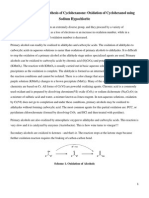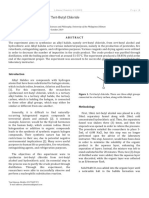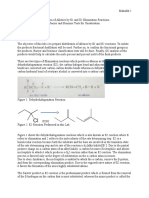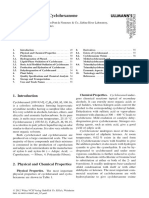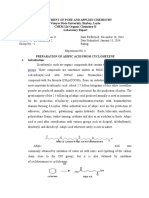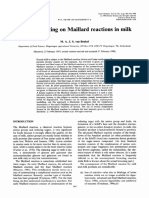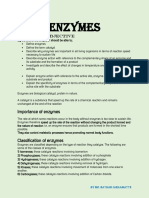Synthesis of Cyclohexanol To Cyclohexene - Lab Report
Synthesis of Cyclohexanol To Cyclohexene - Lab Report
Uploaded by
parisdelapenaCopyright:
Available Formats
Synthesis of Cyclohexanol To Cyclohexene - Lab Report
Synthesis of Cyclohexanol To Cyclohexene - Lab Report
Uploaded by
parisdelapenaOriginal Title
Copyright
Available Formats
Share this document
Did you find this document useful?
Is this content inappropriate?
Copyright:
Available Formats
Synthesis of Cyclohexanol To Cyclohexene - Lab Report
Synthesis of Cyclohexanol To Cyclohexene - Lab Report
Uploaded by
parisdelapenaCopyright:
Available Formats
LBYKM32, NO2A, Group 7
Experiment 2: Synthesis of Cyclohexene from Cyclohexanol
Ching, D., Dela Peña, P., Espartero, F.
Mr. Glenn Kelly Tan
January 24, 2024
February 20, 2024
Abstract
The experiment revolves around the dehydration of cyclohexanol to cyclohexene through a unimolecular
elimination (E1) reaction using an acid-catalyst. Cyclohexanol is used as the starting material so that the
alcohol that will be used will not yield any unwanted product, is reactive enough, and will involve the
product in the liquid phase. As for the acid-catalyst, phosphoric acid was preferred over sulfuric acid
because of its weaker oxidizing properties as well as its weaker acidity. The main objective of the
experiment is the synthesis itself while other objectives include getting a satisfactory percent yield, and
characterizing the product produced by the reaction done. After the reaction is allowed to happen in the
boiling flask, the mixture is then distilled using a fractional distillation setup to separate the desired
product from the starting material, the remaining acid catalyst, and water. Then, liquid-liquid extraction is
then used to further separate the organic layer containing the cyclohexene from the aqueous layer. Then,
to further remove water, the extract was dried using calcium chloride. The dried product was then left for
the next class. The first step in the next session involves using a dropper to transfer the dried product to
the vial for the characterization using gas chromatography-mass spectroscopy but the dropper used was
contaminated so further extraction using saturated sodium chloride was used, Then the product was then
inserted into the vial for characterization. The product contained hexane and other impurities with a
retention factor of 1.50, the desired product cyclohexene with the highest peak and a retention factor of
1.63, and some starting material cyclohexanol with a retention factor of 2.38.
I. Introduction of the acid-catalyst for it to have 3 bonds and a
The preparation of alkenes is done lone pair and therefore having a positive
through elimination reactions, may it be charge. This converts the bad leaving group
bimolecular (E2) or unimolecular (E1). The -OH to a good leaving group -+OH2 as it will
common starting materials used are alkyl prefer to leave as a water molecule. E2
halides and alcohols. The type of reaction that reactions are a concerted process, which
these starting materials undergo depends on means that all of the steps will be happening at
the number of R groups (i.e. carbon atoms or the same time after the acid-base reaction. The
hydrocarbon chains) attached to the alpha -+OH2 group leaves as a water molecule while
carbon, which is the carbon in which the halo the conjugate base coming from the acid-base
group for alkyl halides, or the hydroxy (-OH) reaction attacks a beta hydrogen, whose broken
group for alcohols, is attached. In alkyl halides, bond will be used to form a pi bond between the
elimination is done using a base but, the beta carbon and alpha carbon which then
problem is a non-bulky base can also function results in the desired alkene product. E1
as a nucleophile to do substitution so there reactions are similar to E2 reactions but the
would be two competing reactions. (1) That’s generation of the water molecule will come first
why the synthesis of alkenes will be more forming a carbocation intermediate. This does
favorable when alcohols are used because the not happen for E2 reactions because they
reagents used for substitution are different from cannot form a stable carbocation. The attack of
those used in elimination. the conjugate base then follows through to form
the desired alkene product.
The experiment involves the
dehydration of alcohols using an acid-catalyst to The importance of learning the process
do an elimination reaction. Both E2 and E1 of synthesizing alkenes lies in the reactivity of
reactions require an acid-base reaction first, the pi-bond which means they can act as
which includes a lone pair of the oxygen from intermediates in the synthesis of other complex
the hydroxy group attacking an acidic hydrogen compounds used in industrial applications. (3)
LBYKM32, NO2A, Group 7
For instance, ethylene, the simplest alkene (1), agent clumped together while swirling the flask.
is the organic compound produced at the After adding more pellets, the clumping stopped
greatest quantity worldwide, which reaches up and the colorless final product was decanted
to more than 130 billion kilograms per year. A into a clean, dry test tube and stored with an
bulk of the produced ethylene is polymerized to aluminum foil and stopper.
polyethylene which is the most commonly found
plastic. (3) The sample obtained in this experiment
was soon contaminated with impurities,
II. Experimental indicated by its murky appearance. To fix this,
the product was mixed with saturated sodium
chloride (NaCl) solution and was extracted
again. After removing the aqueous layer, the
organic layer was extracted with hexane to
draw off organic impurities. Anhydrous CaCl2
was added to dry off any water content left in
the extracted sample.
The assumed cyclohexene and hexane
sample was transferred into a small vial by
passing it through a microfilter to remove any
solvents. This vial was run into a gas
chromatography-mass spectrometry (GC-MS)
machine to determine the identity of the
product. (2)
III. Results and Discussion
Figure 1 : Distillation Set-Up The utmost rationale of the experiment is
to perform an elimination reaction mechanism
In a 50-mL boiling flask, 5.2 mL of to dehydrate cyclohexanol to form cyclohexene
cyclohexanol and 1 mL of 85% phosphoric acid with the maximum purity and yield. Ensuring
(H2PO4) were mixed and swirled together. that the reaction proceeds both effectively and
Combining these formed a clear solution. A efficiently almost diminishing the appearance of
boiling chip was added into the distilling flask impurities. It also optimizes the reaction
before it was attached into a fractional condition such as temperature, time, and
distillation set-up. concentration of the acid catalyst, minimizing
decomposition. Understanding the underlying
Heat was applied into the solution, role of acid catalysts, formation of carbocation
allowing it to gently boil for about 5 minutes first intermediates, and the implications of the
before distilling. Clear distillate was collected principles of acid-catalyzed dehydration
between 95.0-105.0 deg C until the residue in reactions. Ultimately, to characterize and
the flask is reduced to 1-1.5 mL. The receiver acquire products using analytical techniques
was submerged in an ice bath to prevent loss of available such an Infrared (IR) Spectroscopy
product by evaporation. and Gas Chromatography--Mass spectroscopy
(GC-MS) in determining the identity and purity
The distillate was then extracted in a of the product.
separatory funnel by mixing it together with 5
mL of distilled water. Two-way separation was The preparation of cyclohexene from
performed, extracting the product with two 2.5 cyclohexanol is via elimination reaction,
mL-portions of water. The solution then specifically dehydration reaction, where a
separated into two clear layers. In every molecule of water is removed from the alcohol
extraction, the lower aqueous layer was drawn to form the corresponding alkene. It involves
off. After this process, the upper organic layer protonation of the alcohol in the presence of a
was decanted into a dry Erlenmeyer flask and strong acid catalyst, the 85% phosphoric acid.
was dried using small amounts of anhydrous Cyclohexanol reacts with the hydronium ion
calcium chloride (CaCl2) pellets. The drying from the acid, paving the way for protonation of
LBYKM32, NO2A, Group 7
the hydroxy group (-OH) of the starting purification purposes. This technique separates
chemical. It forms an alcohol intermediate as different components of a mixture based on
the hydroxyl group was transformed into a their boiling points, allowing for the isolation of
better leaving group. Therefore, it undergoes an pure cyclohexene. Cyclohexene has a lower
elimination reaction where a water molecule is boiling point than water, thus it was distilled off
extracted. The formation of a carbocation first, leaving behind the water and other heavier
intermediate resulted from a hydrogen atom on components.
the carbon atom bonded to the hydroxyl group.
This intermediate therefore undergoes The mixture was separated through the
deprotonation to generate the desired use of separator funnel and technique. Further
cyclohexene product— Resulting in the purification was then performed through the
formation of a double bond between the carbon drying agent, anhydrous calcium chloride
atoms previously bonded to the hydroxyl group. (CaCl2) to remove any remaining water traces.
During the dehydration, a 50-mL Upon transferring the yield of the
round-bottom flask with 5.0g cyclohexanol, experiment in a vial to be used on a gas
1-mL of 85% phosphoric acid, and a boiling chip chromatography–mass spectrometer, the
was equipped with a fractionating column for a dropper used was contaminated with an
reflux to prevent the loss of volatile components unknown organic material. Thus, making the
and ensures continuous reaction until the mixture become cloudy. The initial resolution
volume has been reduce to 1 to 1.5-mL. Thus, a was to dilute the contaminated mixture with
heedful temperature control is critical to prevent water— Observing a homogenous cloudy
overheating and decomposition of the product. solution.
Fractional distillation is utilized to obtain Saturated sodium chloride (NaCl2) was
relative pure cyclohexene ensuring separation added to allow two layers to separate. Unveiling
from other substances. Whereas, cyclohexene to three layers: lower aqueous layer, middle
was collected. While, water and unreacted presumed organic contaminant, upper organic
cyclohexanol are left behind in the flask. Careful layer. The mixture was then concentrated with
employment of techniques is required for hexene for the unknown organic material to
minimizing contamination. cohere with. The extracted cyclohexene with
hexane is then dehydrated with anhydrous
Further distillation of the reaction mixture CaCl2 and decanted. A micro filter was used in
to isolate cyclohexane from the solvent with a drawing out the murky mixture in a vial, making
boiling point: 83°C. It was collected in a it translucent.
separate flask while leaving behind the solvent
and other impurities. Gas chromatography-mass spectrometry
(GC-MS) was utilized to determine the identity
Purification through separation to meet of the by-product. With this combination of
purity necessities and removal of excess analytical techniques, the sample mixture was
aqueous mixture. Additionally, dehydration separated into its components and these were
through the use of anhydrous calcium chloride detected to determine their presence. The
to remove excess water will pave the way for a mass-to-charge ratio was also measured with
more purified product. this instrument to confirm its molecular weight
and to clarify the chemical structure of the
The starting material, cyclohexanol was sample. (3)
carried out using a strong acid catalyst, 85%
phosphoric acid and subjected to heat under
reflux which promoted the removal or water in
the dehydration process. The mixture
containing cyclohexene, water, and probable
unreacted cyclohexanol and acid catalyst
underwent distillation to separate cyclohexene
from water and other impurities. Specifically,
fractional distillation was employed for
LBYKM32, NO2A, Group 7
ratio was 15, confirming the loss of CH3 group.
With this fragmentation pattern, the mass
spectrometry results confirmed the structure of
cyclohexene, the desired product.
IV. Conclusion and Recommendations
In conclusion, the synthesis of
cyclohexane from cyclohexanol involves several
crucial yet straightforward steps, including
dehydration, distillation, and purification, which
necessitate careful precision and attention. By
employing laboratory techniques, a successful
Figure 2 : Gas Chromatography analysis of the
conversion of cyclohexanol into cyclohexene
product
was observed.
Figure above shows the gas
Throughout the experiment, special
chromatography results of the assumed
considerations were implemented to optimize
cyclohexene and hexane sample. At retention
reaction outcomes and minimize side reactions.
time = 1.50, a peak was generated from the
Temperature control, fractional distillation to
presence of hexane and other impurities. The
separate cyclohexene from other components,
highest peak at retention time = 1.63, confirmed
and selection of appropriate catalyst.
the appearance of cyclohexene, the desired
product in this experiment. Lastly, a peak
The final product, cyclohexane, was
generated at retention time = 2.38 was an
obtained through distillation. Although it
indication that the starting reagent,
demonstrated inadequate purity as it is a mixture
cyclohexanol, is still in the sample. With this,
of cyclohexane and hexane. Further purification
this can confirm that the mixture comprises
techniques could be employed if higher purity is
cyclohexene, cyclohexanol, hexane, and other
required for specific applications.
organic impurities.
Overall, the experiment amplified the
importance of meticulous experimental design,
proper technique execution, and attention to
safety protocols in organic synthesis. It could still
be inferred as a successful synthesis of
cyclohexane as it underscores the effectiveness
of the methods and serves as a foundation for
further exploration in organic chemistry
processes.
Moreover, based on the experiment
conducted for the synthesis of cyclohexane from
cyclohexanol, several recommendations can be
Figure 3 : Mass Spectrometry analysis of the made to improve its efficiency and effectivity:
product
1. Increase parameters such as reaction
Next figure is the mass spectrometry time and concentration of reactants to
results of the sample. The mass-to-charge (m/z) maximize the yield of cyclohexane.
= 72 was the molecular ion [C6H10]+, the 2. Conduct on varying conditions.
heaviest ion that passed through the machine. 3. Using higher measures of excess
Its difference to the base peak (m/z = 67) was reagents to ensure a reaction that aims
15 m/z, which confirmed the loss of CH3 group. towards completion.
To the next molecular ion peak (m/z = 54), there 4. Enhance separation and purification
is a difference of 13 m/z, indicating techniques as these are the processes
disappearance of CH group in the sample. To where loss of products is prominent.
the last peak (m/z) = 39, the difference of the 5. Explore different catalysts available for
LBYKM32, NO2A, Group 7
higher activity. “I hereby certify that I have given a
substantial contribution to this report and I
Through implementing these did not copy and/or quote from any resource
recommendations, it is possible to achieve material unless being cited as reference. I
higher yields of cyclohexane from cyclohexanol, am make known that failure to accomplish
thereby increasing the overall efficiency of the the second clause would be grounds for
reaction. plagiarism and a failing grade for my final
laboratory report.”
References
(1) Ault A. Techniques and Experiments for
Organic Chemistry, 6th ed. University Science
Books, 1998.
(2) Smith, J. Organic Chemistry; Third Edition; CHING, DAVID O.
McGraw-Hill: New York, 2011.
(3) Turner, D. 2022. Available at:
https://www.technologynetworks.com/analysis/a
rticles/gc-ms-principle-instrument-and-analyses-
and-gc-msms-362513. Accessed February 21, DELA PEÑA, PARIS RACHEL V.
2024.
(4) Wade, L; Simek,; J. W. Organic Chemistry;
Tenth Global Edition; Pearson Education: ESPARTERO, FRANCES CHERLEE
United Kingdom, 2023.
You might also like
- Environmental Systems and Processes - Principles, Modeling, and Design - Walter J. Weber JRDocument567 pagesEnvironmental Systems and Processes - Principles, Modeling, and Design - Walter J. Weber JRDuygu Akkoç67% (3)
- Preparation of Cyclohexene From CyclohexanolDocument7 pagesPreparation of Cyclohexene From CyclohexanolDumile Nombasa100% (5)
- Benzylidene AcetalDocument9 pagesBenzylidene AcetalsadiaNo ratings yet
- Synthesis of An Alkyl HalideDocument4 pagesSynthesis of An Alkyl HalideClyde Co SorianoNo ratings yet
- Synthesis and Purification of Tert-Butyl Chloride Chem 31.1Document4 pagesSynthesis and Purification of Tert-Butyl Chloride Chem 31.1John Christian LopezNo ratings yet
- Sodium Boronhydride Reduction of CyclohexanoneDocument6 pagesSodium Boronhydride Reduction of CyclohexanoneWan Nur Amira91% (11)
- A Green Method For Synthesis of Cyclohexanone Oxidation of Cyclohexanol Using Sodium HypochloriteDocument6 pagesA Green Method For Synthesis of Cyclohexanone Oxidation of Cyclohexanol Using Sodium Hypochloritefleetfoxes886% (7)
- The Iodine Clock Reaction LabDocument3 pagesThe Iodine Clock Reaction LabVruti Shah100% (1)
- Advanced Training in Fire FightingDocument43 pagesAdvanced Training in Fire FightingSamiul100% (2)
- Chem Lab Report 2 Deol ADocument5 pagesChem Lab Report 2 Deol AMagnolia Kaye Deola100% (1)
- Preparation and Purification of An Alkyl Halide FRDocument6 pagesPreparation and Purification of An Alkyl Halide FRCamille GrefaldiaNo ratings yet
- Expt6 Synthesis of An Alkyl Halide DraftDocument6 pagesExpt6 Synthesis of An Alkyl Halide DraftAnna Sophia EbuenNo ratings yet
- CyclohexeneDocument11 pagesCyclohexeneanon-407590100% (10)
- Exp 3-Reduction of Cyclohexanone With Sodium BorohydrideDocument11 pagesExp 3-Reduction of Cyclohexanone With Sodium Borohydrideakuserai100% (3)
- S P T - B C: Ynthesis and Urification of ERT Utyl HlorideDocument8 pagesS P T - B C: Ynthesis and Urification of ERT Utyl HlorideJose Javier LasalaNo ratings yet
- Synthesis of Tert-Butyl ChlorideDocument4 pagesSynthesis of Tert-Butyl ChlorideJoel AtienzaNo ratings yet
- EXP2 ReportDocument6 pagesEXP2 Reportballa12345No ratings yet
- Experimen 5 Organic ChemistryDocument8 pagesExperimen 5 Organic ChemistryAbd RaHmanNo ratings yet
- Experiment #1Document7 pagesExperiment #1Lakani Tindiwi YangalaNo ratings yet
- Chem 31.1 FR1 SantosDocument5 pagesChem 31.1 FR1 SantosClaire SantosNo ratings yet
- Experiment 6 Organic ChemistryDocument11 pagesExperiment 6 Organic Chemistryjun keat tanNo ratings yet
- Synthesis of Lidocaine: Chemistry 212 LaboratoryDocument4 pagesSynthesis of Lidocaine: Chemistry 212 LaboratoryNuteLLa Gaming (EFL)No ratings yet
- Chemistry 242 Adipic Acid.09Document5 pagesChemistry 242 Adipic Acid.09khaledegy10No ratings yet
- LuzuriagaKenia - PalmaMaría - POST Lab 7Document13 pagesLuzuriagaKenia - PalmaMaría - POST Lab 7MARIA DANIELA PALMA LOORNo ratings yet
- Aldol Condensation Reaction PDFDocument6 pagesAldol Condensation Reaction PDFaizatNo ratings yet
- Formal Report For Synthesis of An Alkyl HalideDocument5 pagesFormal Report For Synthesis of An Alkyl HalideLovelyn Marie Morada Nievales80% (5)
- Aldol Puzzle Lab ReportDocument11 pagesAldol Puzzle Lab Reportlaurabruce27100% (1)
- Exercise No 2. Lab Rep Organic ChemDocument7 pagesExercise No 2. Lab Rep Organic ChemIrish LaudeNo ratings yet
- NaBH4 Reduction of CyclohaxanoneDocument5 pagesNaBH4 Reduction of Cyclohaxanonenurul1110No ratings yet
- Lab Report C3Document5 pagesLab Report C3SumayyahNo ratings yet
- Lab Report 2_nur Aizati Syamimi_2021619306Document10 pagesLab Report 2_nur Aizati Syamimi_2021619306aizatiNo ratings yet
- Dehydration of CyclohexanolDocument4 pagesDehydration of Cyclohexanolcocomelon8454No ratings yet
- HB 31.1FR06Document3 pagesHB 31.1FR06hebieNo ratings yet
- Preparation and Purification of An Alkyl Halide: Kim Lennard C. GarbinDocument3 pagesPreparation and Purification of An Alkyl Halide: Kim Lennard C. GarbinKimLennardCGarbinNo ratings yet
- Hydroboration Oxidation or (1R) (+) Alpha PineneDocument4 pagesHydroboration Oxidation or (1R) (+) Alpha Pinenewilso279100% (1)
- CHM 556 Experiment 5Document12 pagesCHM 556 Experiment 5Amar Safwan100% (1)
- CH 26 AA - Montano - Jiara - SN and E ReactionsDocument3 pagesCH 26 AA - Montano - Jiara - SN and E ReactionsJiara MontañoNo ratings yet
- Formal Report Chem 31.1Document6 pagesFormal Report Chem 31.1Elah PalaganasNo ratings yet
- FR 1 (E6)Document5 pagesFR 1 (E6)JR CastorNo ratings yet
- Synthesis of An Alkyl HalideDocument4 pagesSynthesis of An Alkyl HalideRuther CabralNo ratings yet
- Exer 8gDocument2 pagesExer 8gYen BerboNo ratings yet
- Experiment 12Document17 pagesExperiment 12Yvince LohNo ratings yet
- Hill Et Al 1984 Oxidation of Alcohols Using Calcium Hypochlorite and Solid Liquid Phase Transfer CatalysisDocument1 pageHill Et Al 1984 Oxidation of Alcohols Using Calcium Hypochlorite and Solid Liquid Phase Transfer Catalysiskeinth monterrosoNo ratings yet
- Ullmann S Enc of Industrial Chemistry PLANTA PDFDocument12 pagesUllmann S Enc of Industrial Chemistry PLANTA PDFTaylor PennaNo ratings yet
- Cyclohexanol DehydrationDocument4 pagesCyclohexanol DehydrationVersiformNo ratings yet
- Preparation of Alkenes by E1 and E2 Elimination ReactionsDocument10 pagesPreparation of Alkenes by E1 and E2 Elimination ReactionsMunna PatelNo ratings yet
- Cyclohexanol and CyclohexanoneDocument12 pagesCyclohexanol and Cyclohexanonetatiana alvarezNo ratings yet
- Sodium Borohydride Reduction of Cyclohex PDFDocument8 pagesSodium Borohydride Reduction of Cyclohex PDFhahadindongNo ratings yet
- CyclohexeneDocument13 pagesCyclohexeneRana BlackNo ratings yet
- Maniscript - TotallDocument17 pagesManiscript - Totall79ccpmh4cdNo ratings yet
- Preparation and Purification of An Alkyl HalideDocument8 pagesPreparation and Purification of An Alkyl HalideNoOneGotThisUsernameYetNo ratings yet
- Exp 2Document5 pagesExp 2zanjinyadzaNo ratings yet
- Exp3 Adn OrgaDocument8 pagesExp3 Adn Orgashazlinda9350% (2)
- Department of Pure and Applied Chemistry Visayas State University, Baybay, Leyte CHEM 126 Organic Chemistry II Laboratory ReportDocument10 pagesDepartment of Pure and Applied Chemistry Visayas State University, Baybay, Leyte CHEM 126 Organic Chemistry II Laboratory ReportKathrynn NaipaoNo ratings yet
- CHM 556 Organic Chemistry 2 Experiment 2: Reduction of CyclohexanoneDocument5 pagesCHM 556 Organic Chemistry 2 Experiment 2: Reduction of CyclohexanoneAmirul Azhar100% (1)
- CHE 222 Lab Report 2Document2 pagesCHE 222 Lab Report 2Alexis GurrNo ratings yet
- Experiment 2 chm556 Organic ChemistryDocument8 pagesExperiment 2 chm556 Organic ChemistryAmar SafwanNo ratings yet
- DehydrationDocument19 pagesDehydrationapi-338215029No ratings yet
- Synthesis of An Alkyl HalideDocument4 pagesSynthesis of An Alkyl HalideJoseph CatiisNo ratings yet
- Preparation and Purification of An Alkyl HalideDocument4 pagesPreparation and Purification of An Alkyl HalideDaphne MercadoNo ratings yet
- Sustainable synthesis of ciclopentene derivatives through multicomponent reactions in continuous flow regimeFrom EverandSustainable synthesis of ciclopentene derivatives through multicomponent reactions in continuous flow regimeNo ratings yet
- Advanced Pharmaceutical analysisFrom EverandAdvanced Pharmaceutical analysisRating: 4.5 out of 5 stars4.5/5 (2)
- AIPMT SOLUTIONS 2011 (English)Document35 pagesAIPMT SOLUTIONS 2011 (English)Resonance KotaNo ratings yet
- Yamazaki Et Al 2021 Sequential Knoevenagel Condensation Cyclization For The Synthesis of Indene and BenzofulveneDocument14 pagesYamazaki Et Al 2021 Sequential Knoevenagel Condensation Cyclization For The Synthesis of Indene and BenzofulveneCarmen AguilarNo ratings yet
- SM Chapter 15Document51 pagesSM Chapter 15李承家No ratings yet
- Chemical Engineering Lab ReportDocument7 pagesChemical Engineering Lab ReportNazario Emil LintagNo ratings yet
- UNIT-III: Photochemical Reactions: PresentationDocument7 pagesUNIT-III: Photochemical Reactions: PresentationSubhasish DashNo ratings yet
- 1120 Lab Packet Fa 17Document37 pages1120 Lab Packet Fa 17abhishek kumar50% (2)
- Rusting Lab PracticeDocument3 pagesRusting Lab Practiceitziarcc100% (2)
- Chapter 17: Alcohols and Phenols: Based On Mcmurry'S Organic Chemistry, 7 EditionDocument36 pagesChapter 17: Alcohols and Phenols: Based On Mcmurry'S Organic Chemistry, 7 EditionArk Olfato ParojinogNo ratings yet
- Reaction Notes For Organic ChemistryDocument11 pagesReaction Notes For Organic ChemistryTyler Lawrence CoyeNo ratings yet
- Bilangan Oksidasi NitrogenDocument10 pagesBilangan Oksidasi NitrogenWidya FatmawatiNo ratings yet
- Physical ChemistryDocument6 pagesPhysical ChemistryAnand MurugananthamNo ratings yet
- Perspective: Microwave-Assisted Synthesis of Metal-Organic FrameworksDocument10 pagesPerspective: Microwave-Assisted Synthesis of Metal-Organic FrameworksHa HoangNo ratings yet
- Effect of Heating On Maillard Reactions in Milk: M. A. J. S. Van BoekelDocument12 pagesEffect of Heating On Maillard Reactions in Milk: M. A. J. S. Van BoekelVaqueroTraviesoNo ratings yet
- C5 Chemical Changes Exam QuestionsDocument10 pagesC5 Chemical Changes Exam QuestionsfrancescoNo ratings yet
- 2.10 Zero-Order ReactionsDocument4 pages2.10 Zero-Order ReactionsDr-SabaJamilNo ratings yet
- 23.1 Introduction To Functional GroupsDocument6 pages23.1 Introduction To Functional GroupsSelim MejiaNo ratings yet
- Energetics MCQDocument6 pagesEnergetics MCQCenturo VinNo ratings yet
- AS/A2 Chemistry Teacher Courses: London and Manchester September 2010 - May 2011Document12 pagesAS/A2 Chemistry Teacher Courses: London and Manchester September 2010 - May 2011AllanMoreiraNo ratings yet
- Organometallic CatalysisDocument5 pagesOrganometallic CatalysisMuhammad Hassan ZiaNo ratings yet
- Enzymes .Document6 pagesEnzymes .Nathan SsekamatteNo ratings yet
- Friedel-Crafts Acylation of TolueneDocument6 pagesFriedel-Crafts Acylation of TolueneKybernetikumNo ratings yet
- Copper I IodideDocument7 pagesCopper I IodideBeatriz CorreiaNo ratings yet
- A Perspective On Hydrothermal Processing of Sewage Sludge: SciencedirectDocument11 pagesA Perspective On Hydrothermal Processing of Sewage Sludge: Sciencedirectfarida_crNo ratings yet
- Lech204 PDFDocument22 pagesLech204 PDFPaula ManolacheNo ratings yet
- Chemistry of Benzene: Electrophilic Aromatic SubstitutionDocument35 pagesChemistry of Benzene: Electrophilic Aromatic SubstitutionDanny Jorge Huicy FernandezNo ratings yet
- Dynamic Modeling and Reaction Invariant Control of PH: February AcceptedDocument10 pagesDynamic Modeling and Reaction Invariant Control of PH: February AcceptedAnaSouzaEQNo ratings yet
- 2020 Sec 4 Pure Chemistry SA2 Singapore Chinese Girls AnswerDocument10 pages2020 Sec 4 Pure Chemistry SA2 Singapore Chinese Girls AnswerWANG JIXIANG JASON HCINo ratings yet






